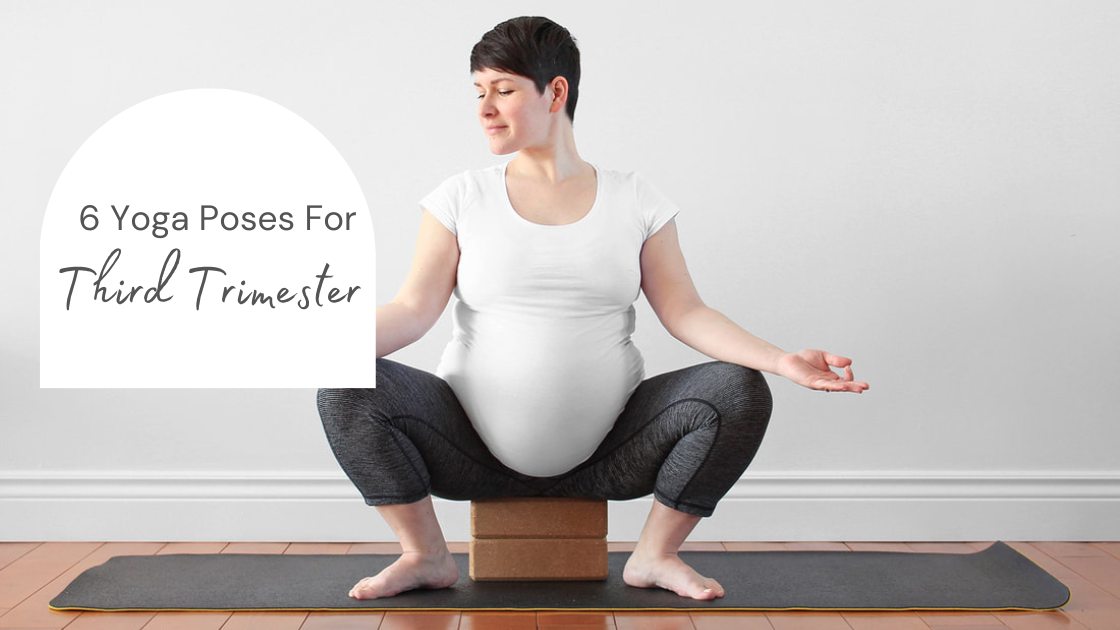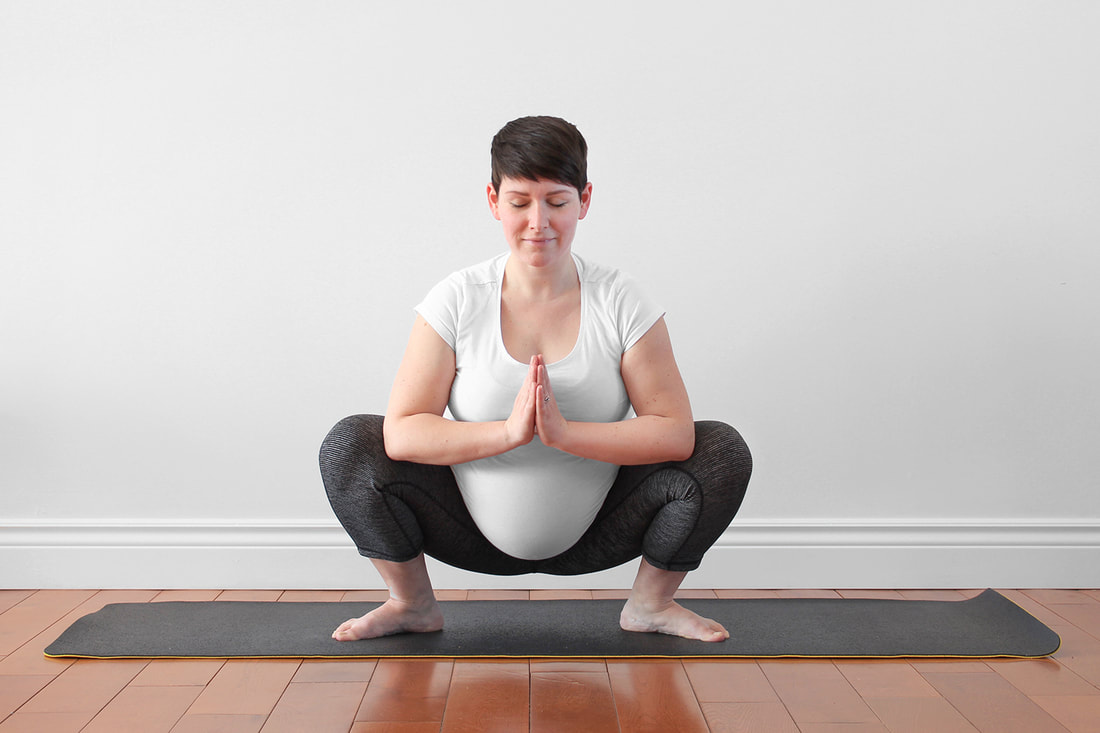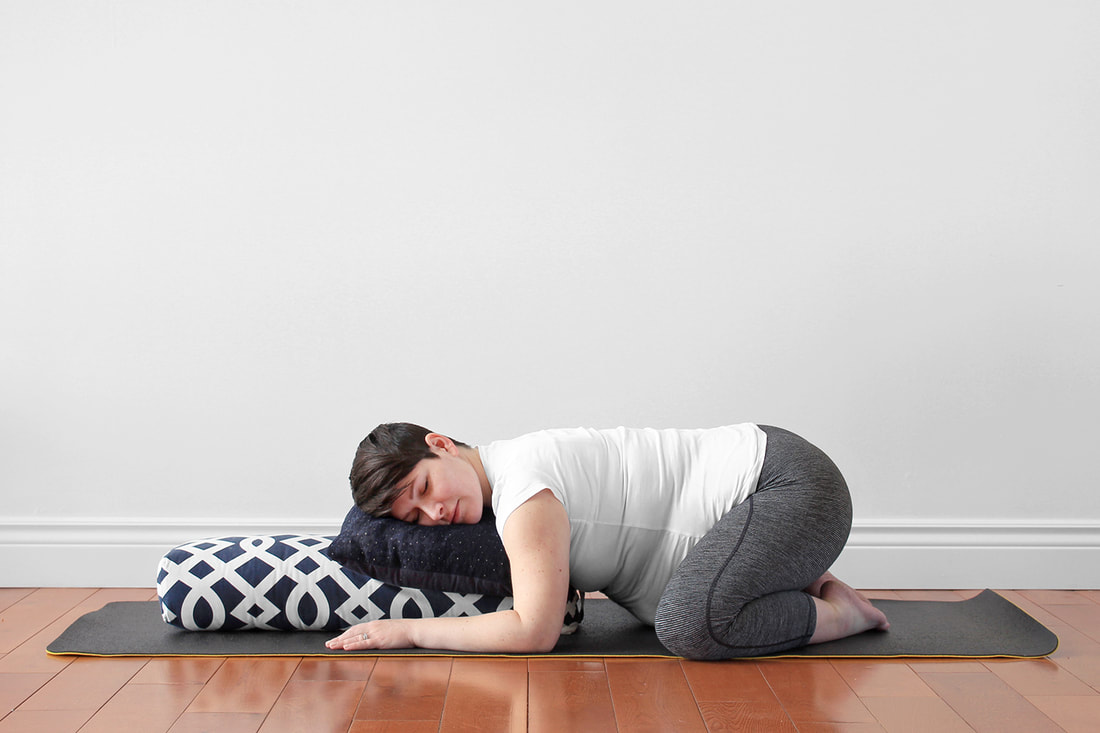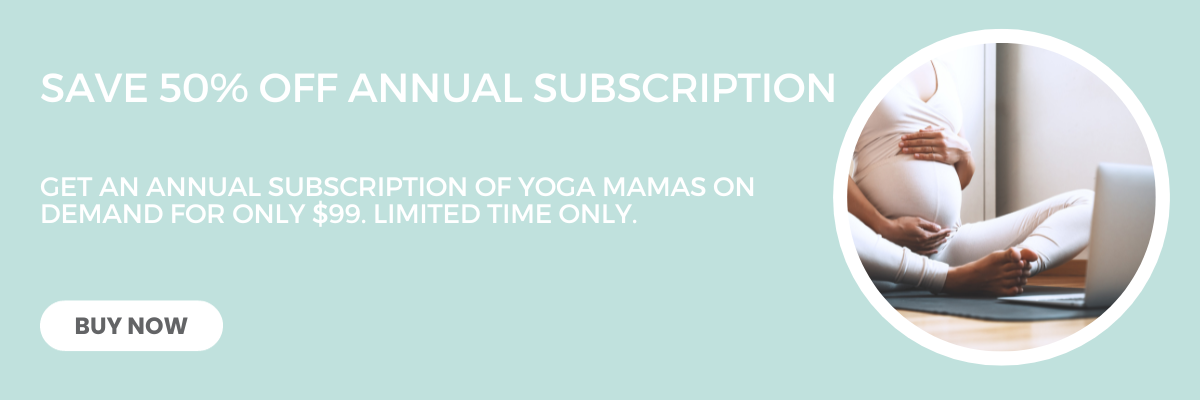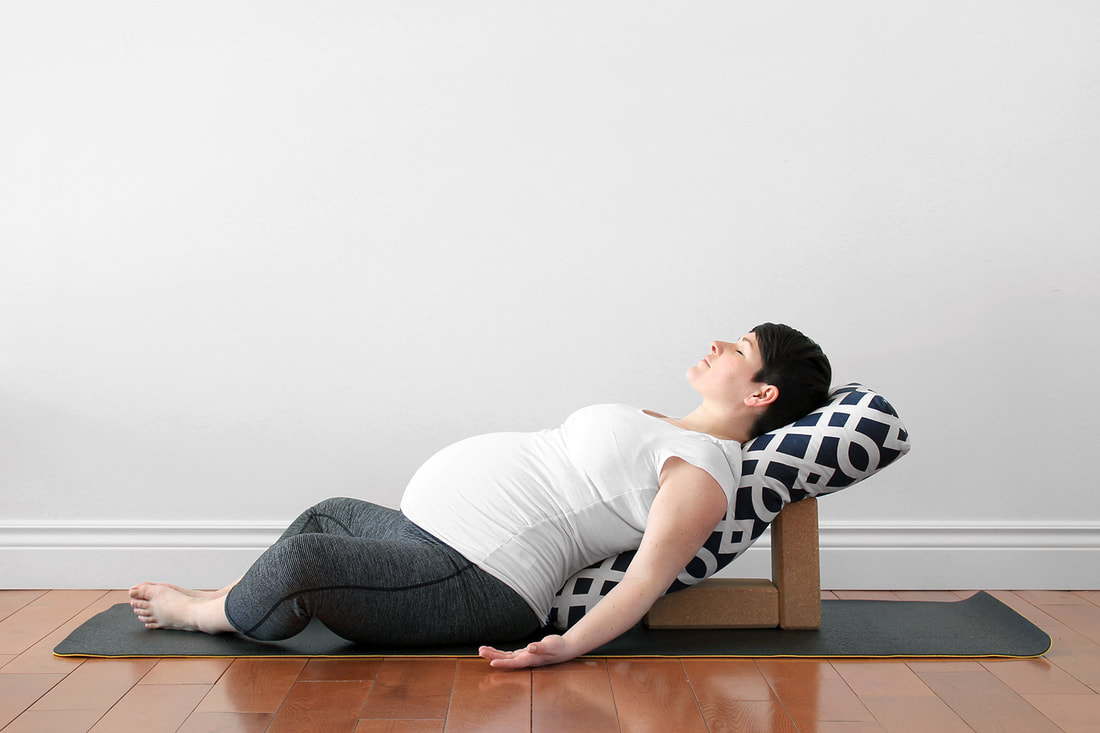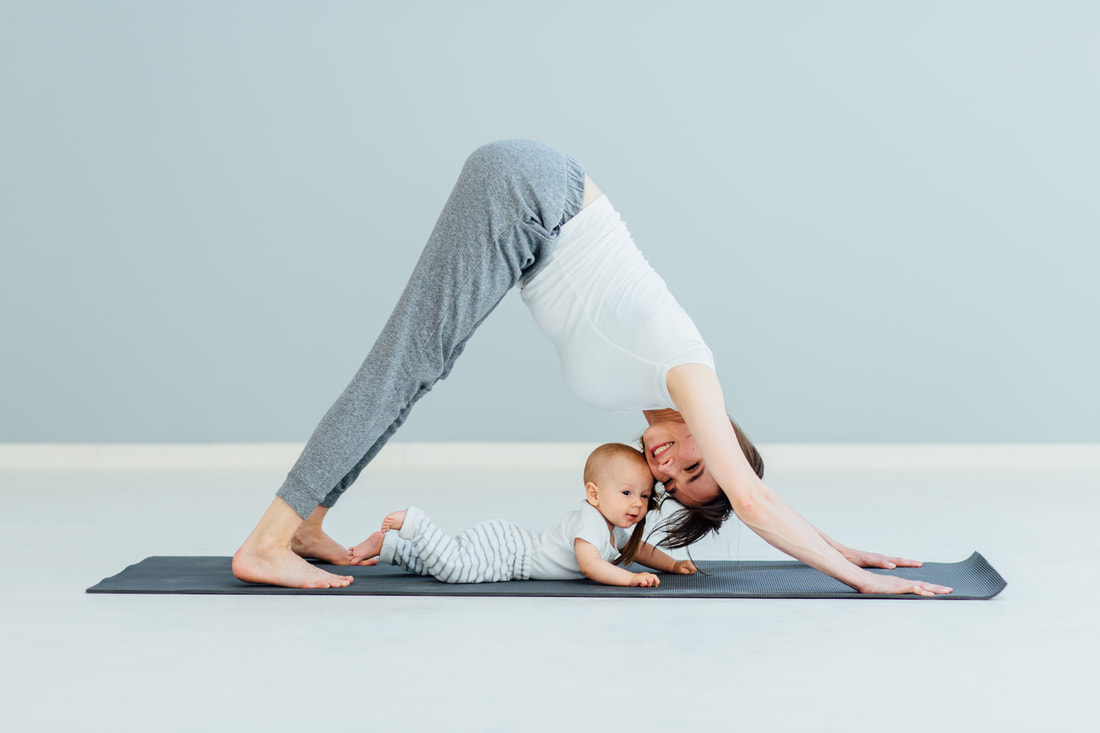|
Congratulations Mama, you’ve almost reached the finish line! The third trimester of pregnancy can be full of mixed emotions—the excitement of meeting your new baby, the fear of being a first-time parent, the bittersweet knowledge that your pregnancy is coming to an end—that said, this is the perfect time to turn to your yoga practice for affirmation and grounding. Today we’re sharing six yoga poses, which are ideal for women in their 3rd trimester. In addition to your mat, you may like to have two blocks or a stool on hand, as well as a bolster or 2-3 pillows. If you’re not yet in your 3rd trimester, check out our prior posts featuring poses for your 1st trimester and 2nd trimester. Goddess Pose Although the final months of pregnancy may have you feeling anything but divine, a little time spent in Goddess Pose will light a strengthening fire in your legs, and help you to harness the maternal vibrations of birthing women everywhere! Goddess is a powerful pose, which builds strength, challenges the mind, and opens the hips. Step your feet wide along the length of your mat, toes pointing outwards. Bend your knees, making sure they don’t overpass your toes, and let gravity guide your tailbone downward. Place your arms anywhere they feel comfortable; resting on your thighs, in a prayer, or palms turned upward. Stay low in this pose for 5-7 cycles of breath, before straightening your legs and gently stepping your feet together. Tip: Bring a swaying side-to-side motion to your Goddess Pose in order to cope with the challenging stance. This movement is also a great tool to use during labor! Squat Time to move a little deeper with another hip opening pose! Squatting not only strengthens the pelvic floor, but it also offers you the chance to experiment with this pose as a birthing position. [Note that if you are over 30 weeks pregnant and your baby is in breech position, you should omit squatting from your practice.] Step your feet a little wider than hip distance apart, with toes pointed slightly outwards. With your hands in a prayer, breathe in and, as you breathe out, draw-up through your pelvic floor. Keeping your pelvic floor engaged, bend your knees and let your hips lower towards the earth (Use a block for added support). Stay low in this pose for 5-7 cycles of breath before bringing your hands to the ground for support and gently straightening your knees and torso. Tip: Using your breath as a guide, try engaging and releasing the muscles in your pelvic floor while maintaining the squat. Bridge Pose Between a growing baby, a placenta, amniotic fluid, and additional water retention throughout the body, your pelvis and lower back are bearing quite a load! Bridge Pose elevates your hips, temporarily alleviating pressure in the pelvic bowl. From a lying position with fingertips reaching towards your feet, bend your legs and ground the soles of your feet close to your seat at hip-width apart. Slowly lift your hips by rolling through your spine, one vertebra at a time. Imagine your spine is creating a long line extending from your thighs all the way to your shoulders. Enjoy 3-5 cycles of breath before slowly lowering your hips back to the mat. Tip: For a more supportive version of this pose, use a block or a stack of pillows under your seat to support the weight of your hips. Wide Legged Child Pose Long before you settle into Savasana, a balanced yoga practice will include opportunities to pause and recoup your energy. Not only is Child’s Pose especially beneficial in your prenatal practice, but it’s also a great position for resting in between contractions during labor! From a kneeling position, bring your toes to touch and separate your knees slightly wider than your mat. Place a bolster or stack of pillows on the mat in front of you and slowly lower your torso. Your head and chest should be completely comfortable and supported by the pillows, leaving ample room for your belly. Relax your arms on either side of the pillows and enjoy 6-8 cycles of breath before pushing yourself back up to a seated position. Tip: Halfway through the pose, turn your head to rest on the opposite cheek in order to achieve a balanced stretch through your neck and shoulders. Legs Up The Wall Getting your pregnant body into this pose requires some (less than glamorous) maneuvering—however, once you’re in it, you’ll want to hang out all day! Resting with your legs up the wall allows gravity to assist blood flow back to your heart and is known to reduce swelling in the feet and ankles. Place a bolster, pillow, or folded blanket against the wall. Sitting to the left of your props, stack your knees to the left and scoot your bottom as close to the wall as possible. Gently lower your body to lie on your left side, then roll your bottom onto your props! You will likely have to shimmy your booty back until it touches the wall. Extend your legs up at about hip distance apart, and relax. Rest here for 6-8 cycles of breath before rolling onto your left side and pushing yourself back to a seated position. Tip: If you’re finding it difficult to release all tension from your legs, try bending your knees away from one another and bringing the soles of your feet to touch just above your hips. Savasana I (On Your Side) Final resting pose—everyone’s favourite! This side-lying version of Savasana is a classic position for prenatal yoga practice and another great option for relaxation between contractions during labor. From a seated position, gently lower your body, coming to lie on your left side. Place a bolster or pillow in front of your hips. Keeping your left leg extended along your mat, bend your right knee and rest your leg on your prop. Place a pillow under your head and make any other small adjustments necessary before settling into stillness. Give yourself permission to relax here for 5-10 minutes. Tip: Ask your doula or birth partner to give you a massage while you rest. Be sure to let them know of any achy areas that need special attention. Savasana II (On Your Back)
Some Yoga Mamas prefer to lie on their back for Savasana—and the good news is it can be done safely with a few adjustments. Although lying flat on your back for prolonged periods is bound to cause discomfort under the weight of your belly (in addition to reducing blood flow to Baby), keeping your torso on an incline feels perfectly comfortable. Prepare two blocks in an “L” shape on your mat (as shown), and then lay a bolster on the blocks (you can also use a generous stack of pillows). Sit with your bottom at the edge of the props. Bring the soles of your feet together, and let your knees fall outwards. Gently lower yourself back on the incline, feeling fully supported by your props. Give yourself permission to relax here for 5-10 minutes. Tip: For even deeper relaxation, cover your body with your favourite blanket, and place an aromatherapy eye pillow over your eyes for the duration of the pose. This is it Mama, the home stretch! It won’t be long before your bun-in-the-oven is snuggled within your arms. We hope your prenatal yoga practice has been a way for you to strengthen your body, connect with your baby, and honour this phase of Motherhood. Light and love be with you on the rest of your journey! Find out which yoga poses are ideal for your 1st trimester and 2nd trimester. Comments are closed.
|
Categories
All
Archives
July 2024
|
-
Wellness Services
- Wellness Concierge
- Abdominal Massage
- Acupuncture
- Cosmetic Acupuncture
- Cesarean Scar Release Therapy
- Chinese Herbal Medicine
- Chiropractic Care
- Counselling >
- Craniosacral Therapy
- Online EFT Tapping
- Fascial Stretch Therapy
- Home Visits
- Online Holistic Nutrition
- Gua Sha Glow Facial
- Introduction to Solids
- Infant & Kids Massage
- Infant Sleep Consulting
- Kinesiology
- Kinesio Taping
- Lactation Consulting
- Light Therapy >
- Lymphatic Drainage Massage
- Massage Therapy
- Naturopathic Medicine
- Osteopathy
- Pelvic Floor Physiotherapy
- Physiotherapy
- Pediatric Physiotherapy
- Online Speech Language Therapy
- Ultrasound For Blocked Ducts
- Vitamin Injections
- FITNESS
- Doula Care
- WORKSHOPS & EVENTS
- Free Events
- Professional Trainings
- Blog
- SHOP ONLINE
Services |
ABOUT US |
|
A Note About yoga Mamas' Cancellation Policies
Please note that we do not offer refunds. Each event/course/training/wellness appt has it's own specific cancellation policy which is listed on each registration page. Please take the time to read these in full prior to registering. Each event/appointment that we run is in partnership with a practitioner who is focusing their independent career in prenatal and postpartum health. This is their beautiful livelihood. This is why we have these policies in place. Thank you very much for your understanding. Jamie Kalynuik, Founder of Yoga Mamas
[email protected] | 416-406-0116 | 1402 Queen St E Suite D. Toronto M4L 1C9
-
Wellness Services
- Wellness Concierge
- Abdominal Massage
- Acupuncture
- Cosmetic Acupuncture
- Cesarean Scar Release Therapy
- Chinese Herbal Medicine
- Chiropractic Care
- Counselling >
- Craniosacral Therapy
- Online EFT Tapping
- Fascial Stretch Therapy
- Home Visits
- Online Holistic Nutrition
- Gua Sha Glow Facial
- Introduction to Solids
- Infant & Kids Massage
- Infant Sleep Consulting
- Kinesiology
- Kinesio Taping
- Lactation Consulting
- Light Therapy >
- Lymphatic Drainage Massage
- Massage Therapy
- Naturopathic Medicine
- Osteopathy
- Pelvic Floor Physiotherapy
- Physiotherapy
- Pediatric Physiotherapy
- Online Speech Language Therapy
- Ultrasound For Blocked Ducts
- Vitamin Injections
- FITNESS
- Doula Care
- WORKSHOPS & EVENTS
- Free Events
- Professional Trainings
- Blog
- SHOP ONLINE

